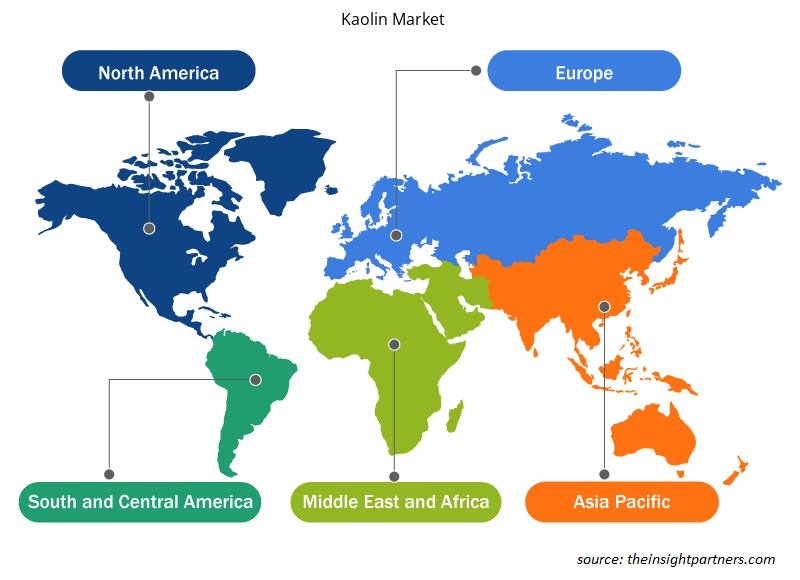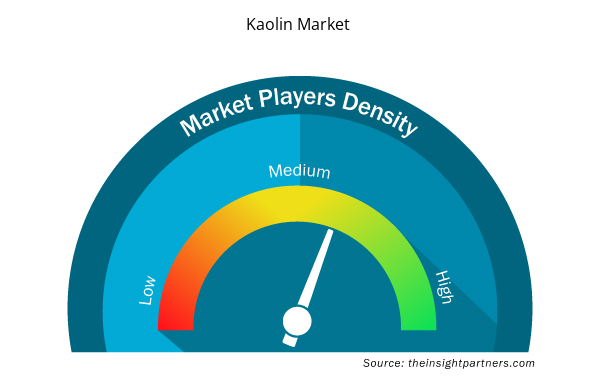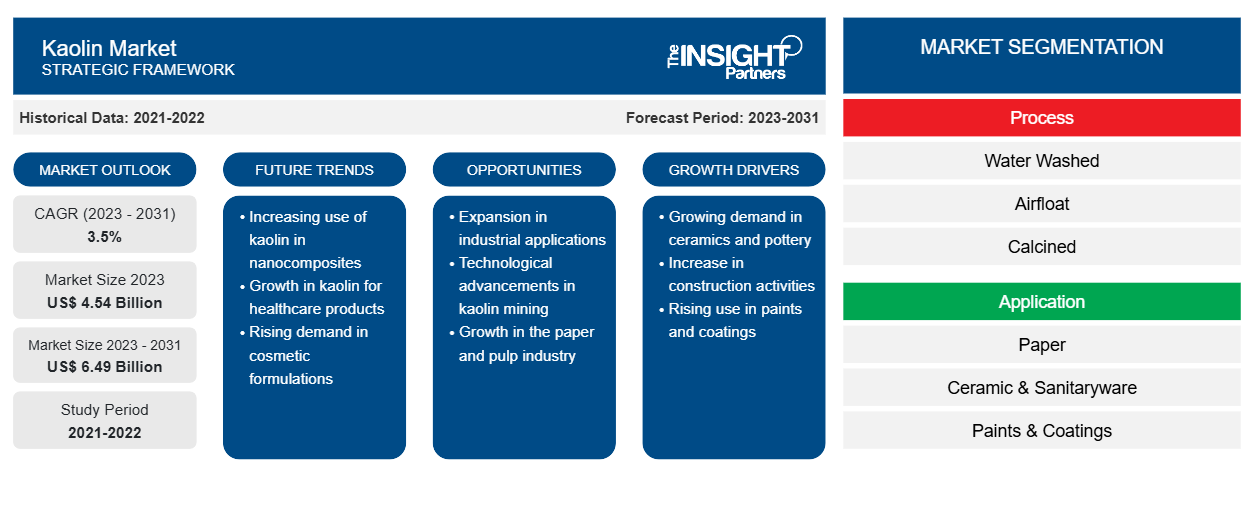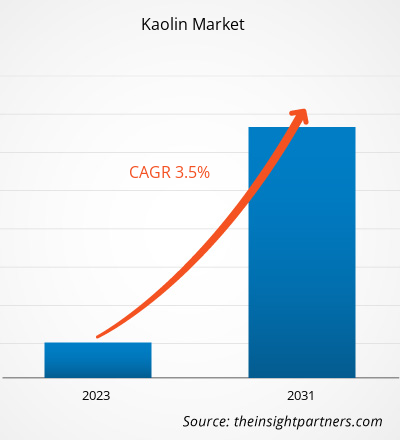Si prevede che la dimensione del mercato del caolino raggiungerà i 6,49 miliardi di dollari entro il 2031, rispetto ai 4,54 miliardi di dollari del 2023. Si prevede che il mercato registrerà un CAGR del 3,5% nel periodo 2023-2031. La crescente domanda da parte delle industrie di utilizzo finale, tra cui imballaggi di carta, plastica, gomma, vernici e rivestimenti e sanitari, rimarrà probabilmente una tendenza chiave nei mercati del caolino.
Analisi del mercato del caolino
La crescente domanda di automobili a livello globale sta favorendo la crescita del mercato del caolino. L'industria automobilistica è uno dei principali beneficiari dei prodotti al caolino, poiché utilizza ampiamente componenti e parti in gomma. Il caolino migliora le proprietà chimico-fisiche e le prestazioni dei componenti automobilistici in gomma. Il caolino è ampiamente utilizzato negli pneumatici per autoveicoli per fornire rigidità e rinforzare la gomma, conferendo agli pneumatici proprietà di resistenza allo strappo e resistenza alla trazione. Inoltre, aiuta a migliorare la permeabilità all'aria e la barriera ai gas delle fodere interne degli pneumatici, il che prolunga la durata utile degli pneumatici. Inoltre, il caolino trova ampia applicazione nelle guarnizioni della carrozzeria delle auto grazie alla ridotta conduttività elettrica, che protegge dalle proprietà di corrosione. Inoltre, il caolino viene utilizzato per produrre componenti automobilistici come gli O-ring in fluoroelastomero per guarnizioni degli iniettori di carburante, guarnizioni e tubi flessibili. Inoltre, il caolino trova applicazione nella produzione di vernici e rivestimenti a base d'acqua, ampiamente utilizzati nell'industria automobilistica per verniciare e rivestire parti e superfici di automobili.
Panoramica del mercato del caolino
Sono disponibili diversi tipi di caolino. Tra i più importanti, il caolino lavato con acqua, il caolino calcinato, il caolino delaminato e il caolino airfloat. Il caolino è ampiamente utilizzato come riempitivo nei settori medico, delle vernici e dei rivestimenti, della carta, della gomma e di altri usi finali. Inoltre, l'aumento della produzione di carta e il suo utilizzo nei settori commerciale e dell'istruzione contribuiscono alla crescita del mercato del caolino.
Personalizza questo report in base alle tue esigenze
Riceverai la personalizzazione gratuita di qualsiasi report, comprese parti di questo report, o analisi a livello nazionale, pacchetto dati Excel, oltre a usufruire di grandi offerte e sconti per start-up e università
- Scopri le principali tendenze di mercato in questo rapporto.Questo campione GRATUITO includerà analisi di dati che spaziano dalle tendenze di mercato alle stime e alle previsioni.
Driver e opportunità del mercato del caolino
La crescente domanda di cosmetici e prodotti per la cura della persona a livello globale rafforza la crescita del mercato del caolino
I prodotti di bellezza e per la cura della pelle stanno assistendo a un aumento dell'applicazione del caolino. Il caolino è ampiamente utilizzato in prodotti di bellezza come ciprie, maschere per il viso, creme e lozioni per pelli grasse, ciprie da bagno, fondotinta, fard in polvere, deodoranti e saponi. Questi prodotti utilizzano il caolino per assorbire l'eccesso di sebo dalla superficie della pelle, sollevando lo sporco e altre impurità dai pori della pelle. Inoltre, il caolino ha proprietà di controllo del sebo, consentendo al trucco di durare più a lungo, resistendo alla sudorazione in condizioni di bagnato o umidità. Inoltre, la crescente domanda di prodotti cosmetici a livello globale sta aumentando la richiesta di caolino. Pertanto, la crescente domanda di cosmetici e prodotti per la cura della persona sta guidando la crescita del mercato del caolino.
Crescente urbanizzazione nelle economie in via di sviluppo
Si prevede che la rapida urbanizzazione nei paesi in via di sviluppo come Cina, India, Brasile e Vietnam rafforzerà la crescita del mercato del caolino. Questi paesi stanno assistendo a un aumento nella costruzione di edifici residenziali e commerciali, che dovrebbe aumentare la domanda di caolino nelle economie in via di sviluppo. Inoltre, il caolino è ampiamente utilizzato nell'industria della ceramica per le sue proprietà di stampaggio. È anche utilizzato nella produzione di sanitari, piastrelle e stoviglie ed è stato utilizzato in modo significativo come sostituto diretto del metodo tradizionale del cemento. Inoltre, l'argilla di caolino è utilizzata come estensore funzionale nelle vernici. Questo perché l'argilla di caolino è chimicamente inerte, ha un elevato potere coprente, conferisce proprietà di scorrimento desiderabili e riduce la quantità di pigmenti costosi richiesti. Si prevede che questi fattori guideranno la crescita del mercato del caolino.
Analisi della segmentazione del rapporto di mercato del caolino
I segmenti chiave che hanno contribuito alla derivazione dell'analisi del mercato del caolino sono il processo e l'applicazione.
- In base al processo, il mercato è segmentato in water-washed, airfloat, calcined, delaminated e altri. Il segmento water-washed ha detenuto la quota di mercato maggiore nel 2023.
- In termini di applicazione, il mercato è segmentato in carta, ceramica e sanitari, vernici e rivestimenti, plastica, gomma e altri. Il segmento della carta ha detenuto la quota maggiore del mercato nel 2023.
Analisi della quota di mercato del caolino per area geografica
L'ambito geografico del rapporto sul mercato del caolino è suddiviso principalmente in cinque regioni: Nord America, Asia Pacifico, Europa, Medio Oriente e Africa, Sud e Centro America.
Molti dei paesi dell'Asia Pacifica, come Cina e India, sono tra le popolazioni in più rapida crescita al mondo. Con una popolazione in crescita, i settori automobilistico, degli imballaggi e delle costruzioni sono molto richiesti nell'Asia Pacifica. Il settore della stampa di imballaggi si sta espandendo nell'Asia Pacifica grazie alla sua vasta gamma di applicazioni. L'esistenza di settori consolidati come alimenti e bevande, elettronica di consumo e molti altri in nazioni come Cina, India, Giappone e Corea del Sud ha aumentato la domanda di soluzioni di imballaggio nella regione. Il mercato degli imballaggi di carta nell'Asia Pacifica ha assistito a una crescita notevole, grazie alla rapida espansione del settore degli imballaggi, alla crescita del settore della vendita al dettaglio di prodotti alimentari e alla crescente consapevolezza dei consumatori sulle soluzioni di imballaggio sostenibili in tutta la regione. Il settore della ristorazione nell'Asia Pacifica si sta espandendo rapidamente, grazie alla rapida crescita economica, alla crescita del settore turistico, al miglioramento degli stili di vita dei consumatori e all'aumento dei livelli di reddito disponibile.
Approfondimenti regionali sul mercato del caolino
Le tendenze regionali e i fattori che influenzano il mercato del caolino durante il periodo di previsione sono stati ampiamente spiegati dagli analisti di Insight Partners. Questa sezione discute anche i segmenti e la geografia del mercato del caolino in Nord America, Europa, Asia Pacifico, Medio Oriente e Africa, e Sud e Centro America.

- Ottieni i dati specifici regionali per il mercato del caolino
Ambito del rapporto sul mercato del caolino
| Attributo del report | Dettagli |
|---|---|
| Dimensioni del mercato nel 2023 | 4,54 miliardi di dollari USA |
| Dimensioni del mercato entro il 2031 | 6,49 miliardi di dollari USA |
| CAGR globale (2023-2031) | 3,5% |
| Dati storici | 2021-2022 |
| Periodo di previsione | 2023-2031 |
| Segmenti coperti | Per processo
|
| Regioni e Paesi coperti | America del Nord
|
| Leader di mercato e profili aziendali chiave |
|
Densità degli attori del mercato del caolino: comprendere il suo impatto sulle dinamiche aziendali
Il mercato del Kaolin Market sta crescendo rapidamente, spinto dalla crescente domanda degli utenti finali dovuta a fattori quali l'evoluzione delle preferenze dei consumatori, i progressi tecnologici e una maggiore consapevolezza dei benefici del prodotto. Con l'aumento della domanda, le aziende stanno ampliando le loro offerte, innovando per soddisfare le esigenze dei consumatori e capitalizzando sulle tendenze emergenti, il che alimenta ulteriormente la crescita del mercato.
La densità degli operatori di mercato si riferisce alla distribuzione di aziende o società che operano in un particolare mercato o settore. Indica quanti concorrenti (operatori di mercato) sono presenti in un dato spazio di mercato in relazione alle sue dimensioni o al valore di mercato totale.
Le principali aziende che operano nel mercato del caolino sono:
- Elementi americani
- Esano
- Azienda di pigmenti Burgess
- Imerys SA
- Sibelco
- Azienda di caolino Thiele
Disclaimer : le aziende elencate sopra non sono classificate secondo un ordine particolare.

- Ottieni una panoramica dei principali attori del mercato del caolino
Notizie e sviluppi recenti sul mercato del caolino
Il mercato del caolino viene valutato raccogliendo dati qualitativi e quantitativi post-ricerca primaria e secondaria, che include importanti pubblicazioni aziendali, dati di associazioni e database. Di seguito è riportato un elenco degli sviluppi nel mercato del caolino:
- BASF ha concluso la cessione della sua attività di minerali di caolino a KaMin, un'azienda globale di minerali ad alte prestazioni con sede a Macon, Georgia, Stati Uniti, in seguito all'adempimento delle condizioni di autorizzazione. (Fonte: BASF SE, comunicato stampa, 2022)
Copertura e risultati del rapporto sul mercato del caolino
Il rapporto "Dimensioni e previsioni del mercato del caolino (2021-2031)" fornisce un'analisi dettagliata del mercato che copre le seguenti aree:
- Dimensioni e previsioni del mercato a livello globale, regionale e nazionale per tutti i segmenti di mercato chiave coperti dall'ambito
- Dinamiche di mercato come fattori trainanti, vincoli e opportunità chiave
- Principali tendenze future
- Analisi dettagliata delle cinque forze di Porter e SWOT
- Analisi di mercato globale e regionale che copre le principali tendenze di mercato, i principali attori, le normative e gli sviluppi recenti del mercato
- Analisi del panorama industriale e della concorrenza che copre la concentrazione del mercato, l'analisi della mappa di calore, i principali attori e gli sviluppi recenti
- Profili aziendali dettagliati
- Analisi storica (2 anni), anno base, previsione (7 anni) con CAGR
- Analisi PEST e SWOT
- Valore/volume delle dimensioni del mercato - Globale, regionale, nazionale
- Industria e panorama competitivo
- Set di dati Excel



Report Coverage
Revenue forecast, Company Analysis, Industry landscape, Growth factors, and Trends

Segment Covered
This text is related
to segments covered.

Regional Scope
North America, Europe, Asia Pacific, Middle East & Africa, South & Central America

Country Scope
This text is related
to country scope.
Trends and growth analysis reports related to Chemicals and Materials : READ MORE..
The Insight Partners performs research in 4 major stages: Data Collection & Secondary Research, Primary Research, Data Analysis and Data Triangulation & Final Review.
- Data Collection and Secondary Research:
As a market research and consulting firm operating from a decade, we have published and advised several client across the globe. First step for any study will start with an assessment of currently available data and insights from existing reports. Further, historical and current market information is collected from Investor Presentations, Annual Reports, SEC Filings, etc., and other information related to company’s performance and market positioning are gathered from Paid Databases (Factiva, Hoovers, and Reuters) and various other publications available in public domain.
Several associations trade associates, technical forums, institutes, societies and organization are accessed to gain technical as well as market related insights through their publications such as research papers, blogs and press releases related to the studies are referred to get cues about the market. Further, white papers, journals, magazines, and other news articles published in last 3 years are scrutinized and analyzed to understand the current market trends.
- Primary Research:
The primarily interview analysis comprise of data obtained from industry participants interview and answers to survey questions gathered by in-house primary team.
For primary research, interviews are conducted with industry experts/CEOs/Marketing Managers/VPs/Subject Matter Experts from both demand and supply side to get a 360-degree view of the market. The primary team conducts several interviews based on the complexity of the markets to understand the various market trends and dynamics which makes research more credible and precise.
A typical research interview fulfils the following functions:
- Provides first-hand information on the market size, market trends, growth trends, competitive landscape, and outlook
- Validates and strengthens in-house secondary research findings
- Develops the analysis team’s expertise and market understanding
Primary research involves email interactions and telephone interviews for each market, category, segment, and sub-segment across geographies. The participants who typically take part in such a process include, but are not limited to:
- Industry participants: VPs, business development managers, market intelligence managers and national sales managers
- Outside experts: Valuation experts, research analysts and key opinion leaders specializing in the electronics and semiconductor industry.
Below is the breakup of our primary respondents by company, designation, and region:

Once we receive the confirmation from primary research sources or primary respondents, we finalize the base year market estimation and forecast the data as per the macroeconomic and microeconomic factors assessed during data collection.
- Data Analysis:
Once data is validated through both secondary as well as primary respondents, we finalize the market estimations by hypothesis formulation and factor analysis at regional and country level.
- Macro-Economic Factor Analysis:
We analyse macroeconomic indicators such the gross domestic product (GDP), increase in the demand for goods and services across industries, technological advancement, regional economic growth, governmental policies, the influence of COVID-19, PEST analysis, and other aspects. This analysis aids in setting benchmarks for various nations/regions and approximating market splits. Additionally, the general trend of the aforementioned components aid in determining the market's development possibilities.
- Country Level Data:
Various factors that are especially aligned to the country are taken into account to determine the market size for a certain area and country, including the presence of vendors, such as headquarters and offices, the country's GDP, demand patterns, and industry growth. To comprehend the market dynamics for the nation, a number of growth variables, inhibitors, application areas, and current market trends are researched. The aforementioned elements aid in determining the country's overall market's growth potential.
- Company Profile:
The “Table of Contents” is formulated by listing and analyzing more than 25 - 30 companies operating in the market ecosystem across geographies. However, we profile only 10 companies as a standard practice in our syndicate reports. These 10 companies comprise leading, emerging, and regional players. Nonetheless, our analysis is not restricted to the 10 listed companies, we also analyze other companies present in the market to develop a holistic view and understand the prevailing trends. The “Company Profiles” section in the report covers key facts, business description, products & services, financial information, SWOT analysis, and key developments. The financial information presented is extracted from the annual reports and official documents of the publicly listed companies. Upon collecting the information for the sections of respective companies, we verify them via various primary sources and then compile the data in respective company profiles. The company level information helps us in deriving the base number as well as in forecasting the market size.
- Developing Base Number:
Aggregation of sales statistics (2020-2022) and macro-economic factor, and other secondary and primary research insights are utilized to arrive at base number and related market shares for 2022. The data gaps are identified in this step and relevant market data is analyzed, collected from paid primary interviews or databases. On finalizing the base year market size, forecasts are developed on the basis of macro-economic, industry and market growth factors and company level analysis.
- Data Triangulation and Final Review:
The market findings and base year market size calculations are validated from supply as well as demand side. Demand side validations are based on macro-economic factor analysis and benchmarks for respective regions and countries. In case of supply side validations, revenues of major companies are estimated (in case not available) based on industry benchmark, approximate number of employees, product portfolio, and primary interviews revenues are gathered. Further revenue from target product/service segment is assessed to avoid overshooting of market statistics. In case of heavy deviations between supply and demand side values, all thes steps are repeated to achieve synchronization.
We follow an iterative model, wherein we share our research findings with Subject Matter Experts (SME’s) and Key Opinion Leaders (KOLs) until consensus view of the market is not formulated – this model negates any drastic deviation in the opinions of experts. Only validated and universally acceptable research findings are quoted in our reports.
We have important check points that we use to validate our research findings – which we call – data triangulation, where we validate the information, we generate from secondary sources with primary interviews and then we re-validate with our internal data bases and Subject matter experts. This comprehensive model enables us to deliver high quality, reliable data in shortest possible time.


 Ottieni un campione gratuito per questo repot
Ottieni un campione gratuito per questo repot